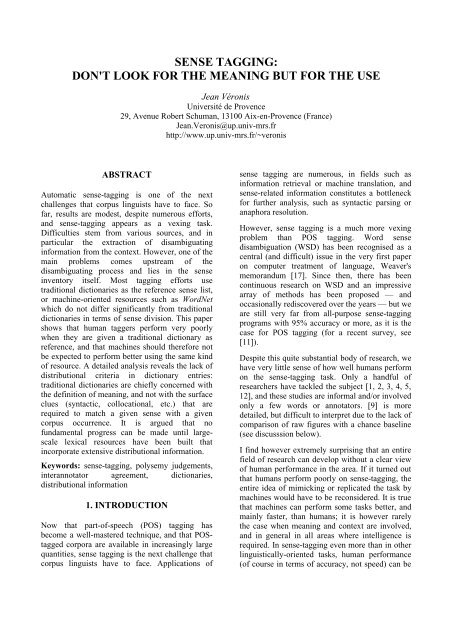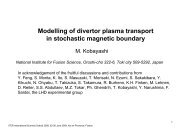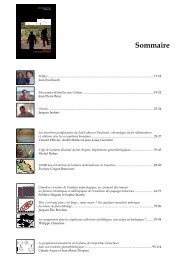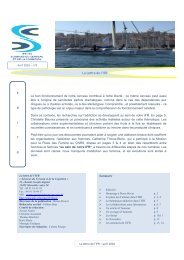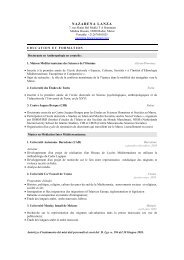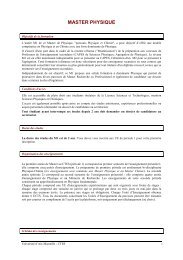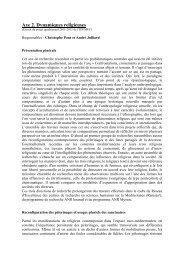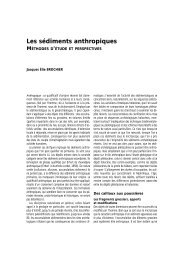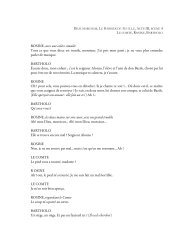sense tagging: don't look for the meaning but for the use
sense tagging: don't look for the meaning but for the use
sense tagging: don't look for the meaning but for the use
You also want an ePaper? Increase the reach of your titles
YUMPU automatically turns print PDFs into web optimized ePapers that Google loves.
and annotators were asked to mark <strong>the</strong> <strong>sense</strong>s inadditional columns. They had <strong>the</strong>re<strong>for</strong>e alloccurrences of <strong>the</strong> same word available on <strong>the</strong>screen. They could mark <strong>the</strong>m in any order, andrevise <strong>the</strong>ir judgement as <strong>the</strong>y were going along.Annotators were instructed to chose ei<strong>the</strong>r one<strong>sense</strong>, or several if <strong>the</strong>y felt that more than onewere appropriate in <strong>the</strong> given context. They couldalso choose no <strong>sense</strong> at all, if <strong>the</strong>y felt that no<strong>sense</strong> in <strong>the</strong> dictionary was appropriate in <strong>the</strong>context. In <strong>the</strong> latter case, <strong>the</strong>y were instructed towrite down a question mark in <strong>the</strong> <strong>sense</strong> column.In <strong>the</strong> subsequent study, <strong>the</strong> question mark wastreated as an additional <strong>sense</strong> <strong>for</strong> each word,grouping all <strong>meaning</strong>s that were not found in <strong>the</strong>dictionary.3.3. ResultsThe annotators gave more <strong>sense</strong>s per context <strong>for</strong>verbs than <strong>for</strong> adjectives and nouns (Table 3,column Nsen). This is likely to be a result of <strong>the</strong>larger number of <strong>sense</strong>s offered <strong>for</strong> verbs in <strong>the</strong>dictionary (see discussion above and Table 2). Theaverage number of <strong>sense</strong>s (<strong>use</strong>d by a single judgein a given context) per POS category is not veryhigh, which shows that annotators have a tendencyto avoid multiple answers (as said above, <strong>the</strong> “no<strong>sense</strong>” answer is counted as a special <strong>sense</strong>).However, <strong>the</strong> average per POS category masksimportant differences between words: <strong>the</strong> averagenumber of responses per word ranges from 1 to to1.311 (verb comprendre). In some cases,annotators <strong>use</strong>d up to six <strong>sense</strong>s in a singleresponse <strong>for</strong> a given context.Agreement was computed according to severalmeasures (summarised in Table 3):(1) Full agreement among <strong>the</strong> six annotators.Two variants were computed:MinMaxCounts agreement when judges agree on all <strong>sense</strong>sproposed <strong>for</strong> a given contextCounts agreement when judges agree on at leastone of <strong>the</strong> <strong>sense</strong>s proposed <strong>for</strong> a given contextThe difference between <strong>the</strong> min and max measuresis not very important, apart from <strong>for</strong> a few words(sûr, comprendre, importer). This is due to <strong>the</strong>fact that <strong>the</strong> average number of <strong>sense</strong>s given byjudges is close to 1 (Table 3, column Nsen). Ofcourse, <strong>the</strong>se measures are biased with <strong>the</strong> numberof judges, as mentioned above. It is howeverstriking to note that <strong>for</strong> some words (correct,historique, économie, comprendre) <strong>the</strong>re was fullagreement on none of <strong>the</strong> contexts <strong>for</strong> that word.(2) Pairwise agreement. Three variants werecomputed:MinMaxWeightedCounts agreement when judges agree on all <strong>sense</strong>sproposed <strong>for</strong> a given contextCounts agreement when judges agree on at leastone of <strong>the</strong> <strong>sense</strong>s proposed <strong>for</strong> a given contextAccounts <strong>for</strong> partial agreement using <strong>the</strong> Dicecoefficient:A∩BDice = 2A + BAgain, <strong>the</strong>re is not much difference between <strong>the</strong>measures, apart from <strong>for</strong> a few words,interestingly enough not exactly <strong>the</strong> same asbe<strong>for</strong>e (chef, comprendre, connaître).(3) Agreement corrected <strong>for</strong> chance. Themeasures above are not completely satisfactory,beca<strong>use</strong> <strong>the</strong>y do not enable comparison ofobserved agreement and agreement that would beobtained by pure chance. The κ statisticsmentioned above enables such a comparison. Inorder to account <strong>for</strong> partial agreement, κ wascomputed on <strong>the</strong> weighted pairwise measure using<strong>the</strong> extension proposed in [8].It is interesting to note that κ ranges between 0.92(noun détention) and 0.007 (adjective correct). Ino<strong>the</strong>r terms, <strong>the</strong>re is no more agreement thanchance <strong>for</strong> some words. The average κ values arelow, below 50%, which indicates a great amountof disagreement among judges.FullPairwisePOS Nsen min max min max wgh κA 1.013 0.43 0.46 0.69 0.72 0.71 0.41N 1.009 0.44 0.45 0.72 0.74 0.73 0.46V 1.045 0.29 0.34 0.60 0.65 0.63 0.41Table 3. Agreement measures per POS catagoryIt is possible that <strong>the</strong> <strong>sense</strong> divisions contained indictionaries are too fine-grained <strong>for</strong> NLP purposes.This argument has been made many times, andmany WSD systems have been restricted tohomograph level or broad <strong>sense</strong> distinctions.In order to test this hypo<strong>the</strong>sis, I have computed<strong>the</strong> degree of inter-annotator agreement when <strong>the</strong>irresponses are reduced to <strong>the</strong> top-level distinctionsmade in <strong>the</strong> dictionary (French dictionaries aremuch more hierarchical than English ones, due todifferent lexicographic traditions). The4
improvement was measured as <strong>the</strong> reduction ofdisagreement once corrected <strong>for</strong> chance, i.e.:1 −κ∆ = 1−1 −κThe results are disappointing: <strong>the</strong> disagreementreduction is only of 8% <strong>for</strong> adjectives and 9% <strong>for</strong>verbs. It is higher <strong>for</strong> nouns, <strong>but</strong> reaches only 25%(Table 4).FullPairwisePOS Nsen min max min max wgh κ ∆(%)A 1.010 0.55 0.57 0.78 0.80 0.79 0.46 7.9N 1.003 0.70 0.70 0.86 0.86 0.86 0.60 25.2V 1.018 0.54 0.56 0.77 0.80 0.79 0.46 8.9Table 4. Agreement on top-level divisions4. DISCUSSION4.1. Summary of resultsExperiment One showed that judges disagreewidely on whe<strong>the</strong>r a given word is polysemous ornot in a corpus. Experiment Two showed that <strong>the</strong>yalso disagree enormously when <strong>the</strong>y have to tagcorpus examples according to <strong>the</strong> <strong>sense</strong> listprovided by a common dictionary. The rate ofdisagreement is so important that <strong>for</strong> some words,<strong>the</strong>re was no more agreement than what would beobtained by mere chance. It cannot be argued that<strong>sense</strong> distinctions are too fine-grained <strong>for</strong> WSD,since, somewhat surprisingly, most disagreementbetween annotators spans across <strong>the</strong> top-leveldivisions of entries.These results shed a new light on automated <strong>sense</strong><strong>tagging</strong>.The dictionary chosen (Petit Larousse) isnot at fault. It is a very respectable medium-sizedictionary which builds on a century and a half oflexicographic tradition. I am convinced that <strong>the</strong>results would be similar with any o<strong>the</strong>r traditionaldictionary.4.2. An example of difficultyThe word degré (=degree) exemplifies <strong>the</strong> type ofdifficulty that annotators are faced with. At <strong>the</strong> toplevel, <strong>the</strong> dictionary gives <strong>the</strong> following divisionsand definitions (I translate roughly and skip <strong>the</strong>sub-<strong>sense</strong>s <strong>for</strong> lack of space):DEGRÉ. I. Literary: step/stair. II. each of <strong>the</strong>intermediary state leading from one state to ano<strong>the</strong>r. III.relative intensity (of an affective, moral or pathologicalstate). IV. each of <strong>the</strong> divisions, corresponding to a unit,21of a scale of measurement.If divisions I and IV are (almost) straight<strong>for</strong>ward,<strong>the</strong> distinction between II and III is extremelyconfusing <strong>for</strong> annotators. In sentences such as:...les trois principaux degrés de cette éliminationétatique: le génocide, la déportation en masse etl'assimilation <strong>for</strong>cée... (...<strong>the</strong> three main steps/levels ofthis state elimination: genocide, mass deportation and<strong>for</strong>ced assimilation...)Ils s'inquiètent de ce qu'ils perçoivent comme un degrécroissant d'anarchie... (<strong>the</strong>y point out <strong>the</strong>ir concernabout what <strong>the</strong>y perceive to be an increasing level oflawlessness...)it is very unclear whe<strong>the</strong>r degré refers to “anintermediary state leading from one state toano<strong>the</strong>r” or a “relative intensity of an affective,moral or pathological state” 3 .In this example, it would however be very easy tosplit <strong>use</strong>s according to syntactic criteria. A first setof <strong>use</strong>s accepts cardinal determiners (un, deux,trois / =one, two, three, etc.) as well as ordinalqualifiers such as premier, second, dernier (=first,second, last):...les trois principaux degrés de cette éliminationétatique → le premier degré, le second degré, etc. (<strong>the</strong>first step, <strong>the</strong> second step, etc.)On <strong>the</strong> o<strong>the</strong>r hand, ano<strong>the</strong>r, disjoint, set of <strong>use</strong>saccepts intensifying qualifiers whose prototype is<strong>the</strong> <strong>for</strong>t/faible (= high/low) pair:un degré croissant d'anarchie → un faible degré, un<strong>for</strong>t degré d'anarchie (a low level, a high level oflawlessness)O<strong>the</strong>r adjectives in <strong>the</strong> paradigm are alarmant(=alarming), élevé (=high), minimal (=minimal),différent (=different), croissant (=increasing), etc.In o<strong>the</strong>r words, one set of <strong>use</strong>s is discrete andcountable, <strong>the</strong> o<strong>the</strong>r set is continuous andintensifiable. Annotators would have little troubleusing <strong>the</strong>se tests, and machines could <strong>use</strong> <strong>the</strong>presence of <strong>the</strong> appropriate adjectives ordeterminers as a reliable disambiguating clue.However, none of <strong>the</strong> French dictionaries that Iexamined <strong>use</strong> or mention this ra<strong>the</strong>r simple3 WordNet 1.6 proposes a similar distinction <strong>for</strong> <strong>the</strong> Englishdegree, resulting in exactly <strong>the</strong> same kind of indecision: 1.a position on a scale of intensity or amount or quality(e.g. : “a moderate degree of intelligence” etc.) 2. aspecific identifiable position in a continuum or series orespecially in a process (e.g. : “a remarkable degree offrankness” etc.). It is hard to see why “degree ofintelligence” and “degree of frankness” should be treateddifferently.5
syntactic property. Worse yet, <strong>the</strong> Petit Laroussedefinitions II and III which at first glance couldcorrespond to this division are in fact at odds withit, as <strong>the</strong> examples and sub-<strong>sense</strong>s reveal.4.3. From <strong>meaning</strong> to <strong>use</strong>It is always easy to point out weaknesses anderrors in entries, in any dictionary. However, mycriticism is of a different nature. I am not trying tospot occasional flaws, <strong>but</strong> questioning <strong>the</strong> verystyle and organisation of entries. In almost all of<strong>the</strong> 60 words <strong>use</strong>d in <strong>the</strong> Experiment Two, <strong>the</strong>definitions (which are after all <strong>the</strong> onlyin<strong>for</strong>mation that annotators have at <strong>the</strong>ir disposalin order to match individual <strong>sense</strong>s with corpuscontexts) do not contain enough clues to per<strong>for</strong>m<strong>the</strong> task safely. Worse yet, <strong>the</strong> division of entriesitself rarely takes into account (and is oftencontradictory with) distri<strong>but</strong>ional facts. Annotatorsall commented on <strong>the</strong> vagueness of definitionsand lack of clear-cut distinctions among <strong>sense</strong>s,which <strong>the</strong>y had never fully realised until <strong>the</strong>y wereconfronted with <strong>the</strong> systematic <strong>tagging</strong> task. Thisvagueness is particularly apparent in abstract, verypolysemous words, such as degré, économie(=economy, economics, saving, etc.),communication (=communication, report,telephone call, etc.), <strong>for</strong>mation (=education,training, <strong>for</strong>ming, <strong>for</strong>mation, etc.), whichconstitute a large part of most texts.The reason <strong>for</strong> this is probably to be found in alexicographic tradition that has its roots in <strong>the</strong>Aristotelian approach to <strong>meaning</strong> and definition.For several centuries, dictionaries have primarilytried to give an account of <strong>meaning</strong>, not of usage(apart from occasional indications of register ordomain). As a result, <strong>the</strong>y rarely provide <strong>the</strong>surface distri<strong>but</strong>ional clues that would enable<strong>sense</strong> discrimination. Only recently somedictionaries (e.g. Cobuild, LDOCE, OALD) havestarted incorporating detailed syntactic,collocational and paradigmatic in<strong>for</strong>mation, usingcorpus evidence instead of lexicographer'sintrospection. This trend is however very newcompared to <strong>the</strong> four-century dictionary buildingtradition, and distri<strong>but</strong>ional in<strong>for</strong>mation in moderndictionaries is still very far from being systematicand precise enough <strong>for</strong> computer <strong>use</strong>. Morecomputer-oriented resources such as WordNetun<strong>for</strong>tunately also almost totally lack this type ofin<strong>for</strong>mation.A major departure from traditional lexicographyhas to be made if we want to accomplishsignificant progress in <strong>sense</strong> <strong>tagging</strong> and o<strong>the</strong>r<strong>sense</strong>-related activities. We have to radically shiftfrom <strong>the</strong> description of <strong>meaning</strong> to that of <strong>the</strong> <strong>use</strong>s.The dictionaries cited above go one step in thatdirection,<strong>but</strong> distri<strong>but</strong>ional in<strong>for</strong>mation is still verymuch conceived as an add-on on top of traditionalfoundations. I will take <strong>the</strong> radical stance thatdistri<strong>but</strong>ional in<strong>for</strong>mation can provide <strong>the</strong> veryfoundations of dictionary organisation, and thatentries can be divided up into coherent usageclasses — that one can think about as <strong>sense</strong>s — on<strong>the</strong> sole basis of that in<strong>for</strong>mation, with no resort to<strong>meaning</strong> analysis and <strong>the</strong> more or lessintrospective or psychological considerations thatsuch analysis usually requires.Although never implemented fully andsystematically in lexicographic work and computerapplications, this point of view is not entirely new.It can be tracked back at least to Meillet [15]:“Le sens d'un mot ne se laisse définir que par unemoyenne entre [ses] emplois linguistiques.” (The <strong>sense</strong>of a word is defined only by <strong>the</strong> average of its linguistic<strong>use</strong>s.)Wittgenstein [18] popularised a similar position in<strong>the</strong> well-known aphorism 4 :“Don't <strong>look</strong> <strong>for</strong> <strong>the</strong> <strong>meaning</strong>, <strong>but</strong> <strong>for</strong> <strong>the</strong> <strong>use</strong>”,and Harris made it part of his linguisticprogramme, by defining “<strong>meaning</strong> as a function ofdistri<strong>but</strong>ion” [10:155-158].4.4. Distri<strong>but</strong>ional in<strong>for</strong>mationIn this section, I will show that entries can bedivided up using various types of distri<strong>but</strong>ionalin<strong>for</strong>mation with no resort to <strong>meaning</strong> analysis. At<strong>the</strong> same time, this in<strong>for</strong>mation is of primaryimportance <strong>for</strong> human annotators and <strong>tagging</strong>systems. I will <strong>use</strong> <strong>the</strong> word barrage (=dam,blocking, roadblock, barrier, etc.) as an example,since while being polysemous, it is not toocomplex <strong>for</strong> <strong>the</strong> space constraints of this paper.4.4.1. Syntactic in<strong>for</strong>mationSyntax provides an extremely powerful tool <strong>for</strong>splitting entries. For example, some <strong>use</strong>s ofbarrage are an active nominalisation of <strong>the</strong> verbbarrer, o<strong>the</strong>rs are not. By active, I mean that <strong>the</strong>nominalisation is a strict synonym of <strong>the</strong> verb, bywhich it can be replaced by changing <strong>the</strong>4 in <strong>the</strong> Philosophische Utersuchungen – he had previouslydefended <strong>the</strong> opposite view in <strong>the</strong> Tractatus.6
construct. At <strong>the</strong> same time, <strong>the</strong> valency of <strong>the</strong>verb is kept in <strong>the</strong> noun; in particular, <strong>the</strong> noun has(or can have) an agent (corresponding to <strong>the</strong> verbsubject) :le barrage de la rivière [par les castors] (<strong>the</strong> blocking upof <strong>the</strong> river [by <strong>the</strong> beavers]) → les castors ont barré larivière (<strong>the</strong> blocking up of <strong>the</strong> river [by <strong>the</strong> beavers]→<strong>the</strong> beavers blocked up <strong>the</strong> river)This <strong>use</strong>, although given as <strong>the</strong> core <strong>sense</strong> by mostdictionaries (“<strong>the</strong> act of blocking”) is in fact veryrare in corpora. It must not be conf<strong>use</strong>d with <strong>the</strong>o<strong>the</strong>r <strong>use</strong>s of barrage which, althoughetymologically <strong>for</strong>med through a nominalisation,have lost <strong>the</strong> direct relationship to <strong>the</strong> verb.le barrage sur le Rhône (<strong>the</strong> dam on <strong>the</strong> Rhône river)→∗ quelqu'un barre le RhôneThis second set of <strong>use</strong>s has developed its ownvalency over <strong>the</strong> centuries, in different ways: afirst subset takes a complement introduced by <strong>the</strong>preposition sur (=on) and a second subset acomplement introduced by à (=to):le barrage sur le Rhône, sur l'autoroute (<strong>the</strong> dam on <strong>the</strong>Rhône river, <strong>the</strong> roadblock on <strong>the</strong> highway)le barrage à la loi sur l'avortement (<strong>the</strong> opposition to <strong>the</strong>abortion law)At this stage, <strong>the</strong> entry is structured as follows:barrage1. barrage de X par Y(= Y barre X)4.4.2. Paradigmatic in<strong>for</strong>mation2.2.1. barrage sur X2.2. barrage à XAno<strong>the</strong>r type of in<strong>for</strong>mation is of paradigmaticnature. For example, one set of <strong>use</strong>s of barragehas a hypernym, ouvrage (≈civil engineeringstructure, no exact translation), while <strong>the</strong> o<strong>the</strong>rshave no hypernym. This assertion may seem odd,since a long Aristotelian tradition, and <strong>the</strong> recentupsurge of ontology development, havecontri<strong>but</strong>ed to <strong>the</strong> widespread feeling that allwords, and all <strong>sense</strong>s of <strong>the</strong>se words, have ahypernym and that <strong>the</strong> lexical space is organisedas a giant taxonomy. It all depends, of course, onwhat we want to call hypernym, and how lax wewant this definition to be. In <strong>the</strong> distri<strong>but</strong>ionalperspective that I am advocating here, I will adopta very strict view of hyperonymy and restrict it to<strong>the</strong> only cases where <strong>the</strong>re is syntagmatic evidenceof <strong>the</strong> relationship, <strong>for</strong> instance in enumerations oranaphoras:les ouvrages "lourds" du GAP, comme le barrageAtatürk ou les tunnels jumeaux d'Urfa... (<strong>the</strong> “heavy”structures built by <strong>the</strong> GAP, such as <strong>the</strong> Atatürk dam or<strong>the</strong> twin tunnels of Urfa...)le barrage d'Assouan … cet ouvrage géant, monstrueux(<strong>the</strong> Hassouan dam ... this giant, monstrous structure)The usual tests such as “is a kind of” simply donot work on most <strong>sense</strong>s, unless we accept todistort language <strong>use</strong> in <strong>the</strong> laxest and mostunnatural way. For example, it is impossible tofind a natural filler <strong>for</strong> <strong>the</strong> pattern “is a kind of ...”<strong>for</strong> <strong>the</strong> <strong>sense</strong> “roadblock” of barrage. Despiteextended search in large corpora, I was unable tofind any syntagmatic evidence of a term that couldbe a satisfactory hypernym.This differential behaviour with respect tohypernyms enables us to subdivide fur<strong>the</strong>r <strong>the</strong> <strong>use</strong>2.1 (barrage sur):2.1. barrage sur XO<strong>the</strong>r types of paradigmatic in<strong>for</strong>mation can be<strong>use</strong>d as well, such as <strong>the</strong> presence or absence ofsynonyms. Here again, I restrict <strong>the</strong> notion to strictsynonyms, i.e. which can be substituted with nochange or loss in a given context. Thesubstitutability can be established by assessingwhe<strong>the</strong>r <strong>the</strong> contexts of <strong>the</strong> candidate synonymsare similar in terms of distri<strong>but</strong>ion (valency, etc.).For example, <strong>use</strong> 2.2 of barrage (barrage à)accepts a strict synonym, obstacle:la volonté de faire barrage (=obstacle) à une probableexpansion du communisme (<strong>the</strong> desire to block aprobable expansion of communism)while no o<strong>the</strong>r subset has any strict synonym. Thisdoes not enable us to subdivide classes fur<strong>the</strong>r, <strong>but</strong>confirms that 2.2 should be a separate class.4.4.3. Collocational in<strong>for</strong>mation2.1.1. ⇑ OUVRAGE2.1.2. (o<strong>the</strong>rs)Collocational in<strong>for</strong>mation is at <strong>the</strong> crossroads ofsyntagmatic and paradigmatic in<strong>for</strong>mation. On onehand it has a syntactic base, since it expresses <strong>the</strong>“preferences” of syntactically bound terms (verbobject,etc.); on <strong>the</strong> o<strong>the</strong>r hand, it enables <strong>the</strong>grouping of words in paradigms that can fulfil agiven syntactic place (e.g.: read a ). This in<strong>for</strong>mation7
can relatively easily be extracted from corporausing grammatical and statistic filters, and manualchecking. In <strong>the</strong> barrage example, this in<strong>for</strong>mationis quite productive. It does not impose fur<strong>the</strong>rdividing, <strong>but</strong> strongly confirms <strong>the</strong> classesestablished so far. For instance, frequent verbswith barrage 2.1.1 as object are construire(=build), édifier (=edify), démolir (=démolish),etc., while verbs associated with barrage 2.1.2 area totally disjoint subset: dresser (=put up),franchir (=cross), démanteler (=dismantle), etc.Figure 2 shows <strong>the</strong> most frequent collocationsassociated with <strong>the</strong> various classes of <strong>use</strong>s <strong>for</strong>barrage, roughly grouped by syntactic category.Glosses are provided between square brackets only<strong>for</strong> <strong>the</strong> sake of readability. It is important to notethat <strong>the</strong> <strong>meaning</strong>s that <strong>the</strong>y are referring to werenot <strong>use</strong>d in <strong>the</strong> splitting process, which was doneonly on distri<strong>but</strong>ional grounds. However,interestingly enough, <strong>the</strong> classes of <strong>use</strong>s obtainedthis way are also coherent from a cognitive pointof view.5. CONCLUSIONIn this paper, I have shown that interannotatoragreement is very low in a straight<strong>for</strong>ward <strong>sense</strong><strong>tagging</strong>task, using a traditional dictionary. Forsome words, agreement was no better than chance.A careful analysis reveals that <strong>the</strong> main difficultiescome from <strong>the</strong> lack of distri<strong>but</strong>ional in<strong>for</strong>mation intraditional dictionaries. Building on severalcenturies of lexicographic tradition, dictionariesmainly attempt to describe and define <strong>meaning</strong>,and ra<strong>the</strong>r marginally give in<strong>for</strong>mation about word<strong>use</strong>s and distri<strong>but</strong>ional data. Only very recentlylexicographers have started making systematic <strong>use</strong>of corpora, and dictionaries still do not containsystematically <strong>the</strong> surface clues (syntactic,collocational, etc.) that are required to match agiven <strong>sense</strong> with a given corpus occurrence. I triedto show that distri<strong>but</strong>ional in<strong>for</strong>mation can provide<strong>the</strong> very foundations of dictionary organisation,and that entries can be divided up into coherentusage classes — that one can think about as<strong>sense</strong>s — on <strong>the</strong> sole basis of that in<strong>for</strong>mation,with no resort to <strong>meaning</strong> analysis and <strong>the</strong> more orless introspective or psychological considerationsthat such analysis usually requires. I am convincedthat large scale lexicons organised this way, andcontaining detailed distri<strong>but</strong>ional in<strong>for</strong>mation arenecessary in order <strong>for</strong> fundamental progress to bemade in <strong>sense</strong> <strong>tagging</strong> and o<strong>the</strong>r <strong>sense</strong>-relatedlanguage processing.BARRAGE1. [act of blocking] barrage de X par Y (+Nomin.
Proceedings of <strong>the</strong> Sixth Midwest ArtificialIntelligence and Cognitive Society Conference,Carbondale, Illinois, April 1995, 73-78.[3] Ahlswede, T. E., & Lorand, D. (1993). TheAmbiguity Questionnaire: A Study of LexicalDisambiguation by Human In<strong>for</strong>mants.Proceedings of <strong>the</strong> Fifth Midwest ArtificialIntelligence and Cognitive Society Conference,Chesterton, Indiana, 21-25.[4] Amsler, R. A., & White, J. S. (1979).Development of a computational methodology <strong>for</strong>deriving natural language semantic structures viaanalysis of machine-readable dictionaries. Finalreport on NSF project MCS77-01315. Universityof Texas at Austin, Austin, Texas.[5] Bruce, R., & Wiebe, J. (1998). Word <strong>sense</strong>distinguishability and inter-coder agreement.Proceedings of <strong>the</strong> 3rd Conference on EmpiricalMethods in Natural Language Processing(EMNLP-98). Association <strong>for</strong> ComputationalLinguistics SIGDAT, Granada, Spain, June 1998.[6] Carletta, J. (1996). Assessing agreement onclassification tasks: <strong>the</strong> kappa statistics.Computational Linguistics, 22(2), 249-254.[7] Cohen, J. (1960). A coefficient of agreement<strong>for</strong> nominal scales. Educational andPsychological Measurement, 20, 37-46.[8] Cohen, J. (1968). Weighted kappa: nominalscale agreement with provision <strong>for</strong> scaleddisagreement or partial credit. PsychologicalBulletin, 70(4), 213-220.[9] Fellbaum, C., Grabowski, J., & Landes, S.(1998). Per<strong>for</strong>mance and confidence in a semanticannotation task. In C. Fellbaum (Ed.), WordNet:An electronic database (pp. 217-237). Cambridge,Massach<strong>use</strong>tts: The MIT Press.[10] Harris, Z. S. (1954). “Distri<strong>but</strong>ionalStructure.” Word, 10, 146-162.[11] Ide, N., & Véronis, J. (1998). Introduction to<strong>the</strong> special issue on word <strong>sense</strong> disambiguation:<strong>the</strong> state of <strong>the</strong> art. Computational Linguistics,24(1), 1-40.[12] Jorgensen, J. (1990). The psychologicalreality of word <strong>sense</strong>s. Journal of PsycholinguisticResearch, 19, 167-190.[13] Kilgarriff, A. (1998). SENSEVAL: AnExercise in Evaluating Word SenseDisambiguation Programs. Proceedings of <strong>the</strong>Language Resources and Evaluation Conference(pp. 581-588). Granada, Spain.[14] Krippendorff, K. (1980). Content Analysis:An introduction to its Methodology. SagePublications.[15] Meillet, A. (1926). Linguistique historiqueet linguistique générale. Vol. 1. Champion, Paris,351pp. (2 nd édition).[16] Véronis, J. (2000). Evaluation of paralleltext alignment systems: <strong>the</strong> ARCADE project. InJ. Véronis (Ed.), Parallel text processing:Alignment and <strong>use</strong> of translation corpora (pp.369-388). Dordrecht: Kluwer AcademicPublishers.[17] Weaver, W. (1949). Translation.Mimeographed, 12 pp., July 15, 1949. Reprintedin Locke, William N. and Booth, A. Donald(1955) (Eds.), Machine translation of languages.John Wiley & Sons, New York, 15-23.[18] Wittgenstein, L. (1953). PhilosophischeUntersuchungen [Philosophical Investigations,translated by G.E.M. Anscombe, New York,Macmillan].9


